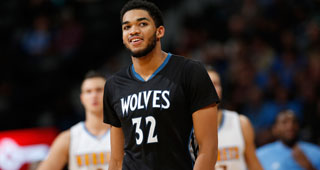The Minnesota Timberwolves began their 15-16 season on a somber note with the sudden passing of Flip Saunders. Saunders had continued Minnesota on their latest rebuild by adding Karl-Anthony Towns in the 2015 NBA Draft to his young roster following their trade for Andrew Wiggins and previously drafting Zach LaVine, Gorgui Dieng and Shabazz Muhammad.
The Wolves seem right on schedule to becoming a playoff team. Towns has been even better than advertised, averaging 18 and 10 with efficient shooting and decent defense. He’s the franchise cornerstone moving forward, in the mold of Kevin Garnett two decades prior. Wiggins seems to be an ideal running mate for Towns, with his blossoming offensive game. LaVine has been terrific since being promoted to the starting lineup permanently after the All-Star break. Without the pressure of being the primary ball handler on the second unit, LaVine has been freed to act as a wing scorer, and he’s been up to the task.
Dieng has also picked up his play since joining the starting five when Garnett was injured. He’s regularly scored in double figures and rebounded well. Muhammad has developed into a solid wing off the bench, playing behind both Wiggins and LaVine. If you add it all up, the Wolves have solid, young pieces at every position. Ricky Rubio is the oldest member of the core rotation and he’ll be just 26 at the start of next season.
Saunders’ stated goal for this season was to surround his young players (the core’s average age is under 23) with veterans, the hope being that the team would mesh quickly and make a playoff push. Veterans like Andre Miller and Kevin Martin have now moved on. Tayshaun Prince seems like he is playing out the string with Minnesota and will move on next year. Only Kevin Garnett seems likely to return next year to close out his career as the veteran voice for the young frontcourt.
With a league high (tied with Utah) 11 players on guaranteed contracts for next season; Minnesota is in a great situation cap-wise. With over $24 million in available projected cap space, the Wolves can go in a few different directions this summer. They can either try to accelerate the rebuild by adding veteran pieces. Or they can continue at their current pace and attempt to add more young talent.
The first step, like many of Minnesota’s fellow lottery teams, comes at the top. Are Milt Newton, the interim GM, and Sam Mitchell, the interim head coach, the right choices to lead Minnesota back to the playoffs? Newton seems far more likely to return than Mitchell. While the Timberwolves’ young talent has shown development, it hasn’t resulted in wins on the court.
If Mitchell is gone, where do the T-Wolves turn next? An underrated option could be Scott Brooks. Brooks’ experience in taking the Thunder from talented young team to contender could be seen as a positive for Minnesota. He’s done it before and the Wolves’ base seems similar to the Oklahoma City base. Towns is a generational talent and Wiggins is coming along quickly. Brooks could use his past experience to make a similar leap again, with Towns/Wiggins playing the Durant/Westbrook roles.
If Minnesota doesn’t go with someone like Brooks, they could look at a younger option like Luke Walton. If Walton wants to leave Golden State, he and the Wolves’ youngsters could mature in to contenders together. Other options are Tom Thibodeau and Jeff Van Gundy, but Minnesota might be too far away from true contention for either of them to be interested.
Once a coach is hired, the Timberwolves desperately need to add shooting. As the roster currently shapes up, only Zach LaVine can be considered a consistent threat from behind the arc. He’s the only player on the roster who will crack 100 threes made this year. Beyond LaVine, Karl-Anthony Towns might be the next best shooter currently on the roster. This lack of shooting and spacing could kill the Wolves’ chances moving forward.
The good thing is that free agency should offer several opportunities to add a shooter. One fit that jumps out is Allen Crabbe. Crabbe has blossomed into a bench weapon as a shooter for the Trail Blazers. He also has a good mid-range shot and he’s a capable ball handler and passer. Crabbe would be ideal as the sixth man for Minnesota. Crabbe is a restricted free agent, so Minnesota would have to give him an offer that Portland wouldn’t be willing to match. But with a lot of cap space and few available roster spots, it is an option worth considering. If signing Crabbe isn’t being considered by the Wolves, they should strongly consider Buddy Hield in the draft, should he fall to them. Hield would give the Wolves a slightly younger, much cheaper version of Crabbe.
Should the team be willing to go a little older, several players would be nice fits. Ryan Anderson could be an ideal frontcourt partner for Dieng and Towns. He could start next to Towns or backup both players. Either way, he would add shooting and rebounding. Jared Dudley would be another nice option with his ability to play the 2-4 positions. Both would be nice veteran influences for a young team as well. Kent Bazemore fits this mold as well, but he may be less likely to take a backup wing role behind Wiggins and LaVine after breaking out as a starter this year with the Atlanta Hawks.
An outside the box idea, if he opts out of his current deal, is Chandler Parsons. With all the talent already at the forward spots, the Wolves could manage Parsons’ minutes, which is a key to keeping him healthy going forward. He’d add outside shooting and some additional playmaking from the SF or small ball PF position. If any of the above aren’t good fits, Minnesota could overpay a veteran for a year or two to fill the shooter role. Players like Courtney Lee, Eric Gordon and Arron Afflalo are options here.
Beyond adding a coach and shooting, the Timberwolves need to decide if Ricky Rubio is the long term point guard to lead this team. If Minnesota wants to move on from Rubio, they can use him as the trade piece to add a shooter. Or they could use him to upgrade by adding a PG on the market like Jeff Teague. If the team wanted to go big, they could try to entice Mike Conley to join the young core and lead the team. A younger option on the RFA market is Tyler Johnson. He was playing great for Miami prior to getting injured. With the Heat’s complicated cap situation, Minnesota could make an offer to Johnson that Miami would have trouble matching. The in-house option at PG is to turn more minutes over to Tyus Jones. While Jones has performed well enough since getting regular backup minutes, he’s not ready to start.
The Timberwolves have the best talent base to build from out of all the lottery teams. They can address issues now and accelerate the rebuild. Or they can continue on the current path and hope for internal improvement. Because they lack roster spots and also have a lot of cap space, the first option lends itself to overpaying a free agent or two for a year or so. Should Minnesota choose the second option, the best bet is to work on a buyout for Nikola Pekovic, who is essentially dead money taking up a roster spot, and take the hit now. That cleans things up going forward quite a bit both for the roster and cap sheet.
Regardless of which path Minnesota chooses this summer, they’ll be a team to watch next year. Either they’ll be continuing to develop their fledgling talent. Or the Timberwolves will be a young squad, supported by veterans, making the first playoff push of many, akin to the rise of the Oklahoma City Thunder that started in the 2010 season.
Offseason Details
Guaranteed Contracts (11): Nemanja Bjelica, Gorgui Dieng, Kevin Garnett, Tyus Jones, Zach LaVine, Shabazz Muhammad, Adreian Payne, Nikola Pekovic, Ricky Rubio, Karl-Anthony Towns, Andrew Wiggins
Partial/Non-Guaranteed Contracts (0): None
Potential Free Agents (3): Tayshaun Prince (UFA), Damjan Rudez (TO – RFA), Greg Smith (UFA)
“Dead” Money on Cap (1): $1,229,584 (Kevin Martin)
First Round Draft Picks (as of 3/30/16): #5
Maximum Cap Space: $26,962,303
Projected Cap Space: $24,278,674



